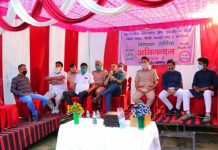
Chandigarh
12 October 2021
DIVYA AZAD
Good blood circulation is vital to a person’s overall health as it ensures that blood and oxygen continuously flow throughout the body. However, clots can form within blood vessels, thereby obstructing the blood flow. This can cause blockages affecting the heart, lungs and other organs.
To raise awareness on clots forming in the blood stream and the importance of getting a thrombosis risk assessment, World Thrombosis Day is observed on 13th October every year. The day coincides with the birthday of Rudolf Virchow, a pioneer in the pathophysiology of thrombosis.
Dr Ravul Jindal, Director, Vascular Surgery, Fortis Hospital Mohali, gave an insight into the causes, symptoms and risk factors of Deep Vein Thrombosis (DVT). Deep vein thrombosis is a clot that usually occurs in the arm or leg, thereby causing severe swelling. The clot can partially or completely block blood flow through the vein. The condition can prove to be life-threatening if not treated in time.
Risk Factors
1. Age: Though DVT can occur at any age, those above 60 are at a higher risk.
2. Prolonged bed rest: Blood clots can form in the calves of legs if a patient is bedridden or hasn’t moved for a long time.
3. Injury: Injury to blood veins or surgery can increase the risk of DVT.
4. Genetics: Genetic factors or disorders, such as V Leiden, are also responsible for causing DVT as it makes the blood clot more easily.
5. Unknown risk factors: Sometimes blood clots occur in veins due to no apparent underlying actors.
Signs & Symptoms
Patients suffering from DVT experience sudden onset of pain and swelling in the arm or leg. In certain serious conditions, patients may experience difficulty in breathing, which indicates that the clots from veins may have travelled to the arteries of the lungs.
Precautions
Ensure to keep yourself well hydrated. One should avoid long travel without compression stockings. Special stockings help compress the legs below the knee, which prevents formation of blood clots. If possible, take small walking breaks. Those with a personal or family history of DVT should wear loose-fitted clothing as tight clothes can constrict blood flow in the waist or legs.
Treatment
The initial treatment is anticoagulation. Anticoagulants, also known as blood thinners, help in dissolving blood clots. Patients with severe swelling undergo Thrombolysis and Thrombectomy, whereby clots are removed from the veins. In some cases, Venous Stenting is conducted, wherein stents are inserted in the affected vein to restore the flow of blood.















































